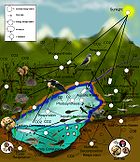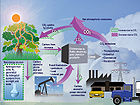- Overpopulation in wild animals
-
Overpopulation in wild animals occurs when a population of a wild species exceeds the carrying capacity of its ecological niche. Overpopulation is a function of the number of individuals compared to the relevant resources, such as the water and essential nutrients they need to survive.
In the wilderness, the problem of animal overpopulation is solved by predators. Predators tend to look for signs of weakness in their prey, and therefore usually first eat the old or sick animals. This has the side effects of ensuring a strong stock among the survivors, and controlling the population.
In the absence of predators, animal species are bound by the resources they can find in their environment, but this does not necessarily control overpopulation. In fact, an abundant supply of resources can produce a population boom that ends up with more individuals than the environment can support. In this case, starvation, thirst and sometimes violent competition for scarce resources may effect a sharp reduction in population in a very short lapse (a population crash). Lemmings, as well as other less popular species of rodents, are known to have such cycles of rapid population growth and subsequent decrease.
Some animal species seem to have a measure of self-control, by which individuals refrain from mating when they find themselves in a crowded environment. This voluntary abstinence may be induced by stress or by pheromones.
In an ideal setting, when animal populations grow, so do the number of predators that feed on that particular animal. Animals that have birth defects or weak genes (such as the runt of the litter) also die off, unable to compete over food with stronger, healthier animals.
In reality, an animal that is not native to an environment may have advantages over the native ones, such being unsuitable for the local predators. If left uncontrolled, such an animal can quickly overpopulate and ultimately destroy its environment.
Examples of animal overpopulation caused by introduction of a foreign species abound:
- In the Argentine Patagonia, for example, European species such as the trout and the deer were introduced into the local streams and forests, respectively, and quickly became a plague, competing with and sometimes driving away the local species of fish and ruminants.
- In Australia, when rabbits were introduced by European immigrants, they bred out of control and ate the farm crops and food that both native and farm animals needed. Farmers hunted the rabbits, and also brought cats in to guard against rabbits and rats. These introduced cats created another problem, becoming predators of local species.
Examples of animal overpopulation caused by natural cyclic variations include:
- the 2004 Locust Outbreak in West and North Africa.
- the Australian locust plagues.
- Palestine's eight month long 1915 locust plague.
See also
- Animal population control
- Culling
- Cascade effect
- Overexploitation
- Overpopulation in companion animals
- Overpopulation
References
Categories:
Wikimedia Foundation. 2010.


